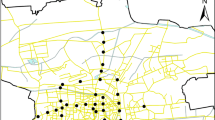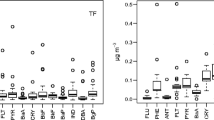Abstract
This paper shows that lichens can be used as biomonitors to distinguish urban from industrial polycyclic aromatic hydrocarbons (PAHs). PAHs are atmospheric pollutants originating mainly from incomplete combustion of fuels in vehicles and industry. The occurrence of PAHs in air is a serious health issue in urban areas and industrial areas because some PAHs are carcinogenic. Biomonitoring PAHs with lichens is generally applied for quantification of PAHs. However, the precise sources of PAHs are not well known. Here we use lichen to trace the source of PAHs. PAHs were analyzed in Pyxine subcinerea Stirton, a lichen species collected from twelve sites which vary from urban and industrial to periurban forest area of Haridwar, in the foothills of the Indian Himalayas. Total PAH concentration ranged between 1.25 and 187.3 μg g−1. Results indicate a clear distinction between urban and industrial PAHs profile, using principal component analysis. Lichen sampled from industrial sites exhibited higher concentrations of two-, five-, and six-ringed PAHs, up to 60% of total PAHs, while samples from urban sites were dominated by four-ringed PAHs, predominantly fluoranthene and acenaphthylene. Molecular ratios indicate that combustion was the dominant source of origin of PAHs in industrial area, while urban sites showed mixed origin of PAHs, both pyro- and petrogenic.

Similar content being viewed by others
References
Augusto S, Maguas C, Matos J, Pereira MJ, Soares A, Branquihno C (2009) Spatial modeling of PAHs in lichens for fingerprinting of multisource atmospheric pollution. Environ Sci Technol 43(20):7762–7769
Augusto S, Maguas C, Matos J, Pereira MJ, Branquihno C (2010) Lichens as an integrating tool for monitoring PAH atmospheric deposition: a comparison with soil, air and pine needles. Environ Pollut 158(2):483–489
Baumard P, Budzinski H, Michon Q, Garrigues P, Burgeot T, Bellocq J (1998) Origin and bioavailability of PAHs in the Mediterranean sea from mussel and sediment records. East Coast Shelf Sci 47:77–90
Bryselbout C, Henner P, Carsignol J, Lichtfouse E (2000) Polycyclic aromatic hydrocarbon in highway plants and soils. Evidence for a local distillation effect. Analusis 28(4):290–293
Dahle S, Savinov VM, Matishov GG, Evenset A, Naes K (2003) Polycyclic aromatic hydrocarbons (PAHs) in bottom sediments of the Kara Sea shelf, Gulf of Ob and Yenisei Bay. Sci Tot Environ 306:57–71
Guidotti M, Stella D, Owczarek M, DeMarco A, De Simone C (2003) Lichens as polycyclic aromatic hydrocarbon bioaccumulators used in atmospheric pollution studies. J Chromatogr 985(1–2):185–190
Halek F, Kianpour-rad M, Kavousi A (2010) Characterization and source apportionment of polycyclic aromatic hydrocarbons in the ambient air (Tehran, Iran). Environ Chem Lett 8:39–44
Hwang HM, Wade TL, Sericano JL (2003) Concentration and source characterization of polycyclic aromatic hydrocarbons in pine needles from Korea, Mexico and United States. Atmos Environ 37:2259–2267
James W, Horn Jamie, Lehner AF (2002) Role of the Bay- and L-regions in the metabolic activation and carcinogenicity of Picene and Dibenz[a,h]anthracene. Polycycl Aromat Compd 22:737–745
Joshi PC, Swami A (2007) Physiological responses of some tree species under roadside automobile pollution stress around city of Hardwar, India. Environmentalist 27:365–374
Khalili NR, Scheff PA, Holsen TM (1995) PAH source fingerprints for coke oven, diesel, and gasoline engines highway tunnels and wood combustion emissions. Atmos Environ 29(4):533–542
Khillare R, Balachandran S, Hoque RR (2005) Profile of PAHs in the diesel vehicle exhaust in Delhi. Environ Monit Assess 105:411–417
Mai BX, Qi SH, Zeng EY et al (2003) Distribution of polycyclic aromatic hydrocarbons in the coastal regions of Macao, China: Assessment of input sources and transport pathways using compositional analysis. Environ Sci Technol 37:4855–4863
Shukla V, Upreti DK (2009) Polycyclic Aromatic Hydrocarbon (PAH) accumulation in lichen, Phaeophyscia hispidula of DehraDun city, Garhwal Himalayas. Environ Monit Assess 149(1–4):1–7
Shukla V, Upreti DK, Patel DK, Tripathi R (2010) Accumulation of polycyclic aromatic hydrocarbons in some lichens of Garhwal Himalayas, India. Int J Environ Waste Manag 5(1–2):104–113. doi:10.1504/IJEWM.2010.029695
Usenko S, Simonich SLM, Hageman KJ, Schrlau JE, Geiser L, Campbell DH, Appleby PG, Landers DH (2010) Sources and deposition of polycyclic aromatic hydrocarbons to western US National Parks. Environ Sci Technol 44(12):4512–4518
USEPA (1986) Test methods for evaluating solid waste, vol 1. Laboratory Manual Physical/Chemical Methods, Washington, D.C
Yang H, Hsieh L, Liu H, Mi H (2005) Polycyclic aromatic hydrocarbon emissions from motorcycles. Atmos Environ 39:17–25. doi:10.1016/j.atmosenv.2004.09.054
Yunker MB, Macdonald RW, Vingarzan R, Mitchell RD, Goyette D, Sylvestre S (2002) PAHs in the Fraser River basin—a critical appraisal of PAH ratios as indicators of PAH ratios as indicators of PAH source and composition. Org Geochem 33(4):489–515
Zhou J, Wang T, Huang Y, Mao T, Zhong N (2005) Size distribution of polycyclic aromatic hydrocarbons in urban and suburban site of Beijing, China. Chemosphere 61:792–799
Acknowledgments
Authors (M.Y. and V.S.) are thankful to the Vice Chancellor, B.B.A. (Central) University, Lucknow. Financial assistance from Department of Science and Technology, New Delhi is gratefully acknowledged (SR/FT/LS-028/2008). We thank Dr. Sudhir Shukla and Ms. Anu Rastogi for statistical analysis. We thank anonymous reviewers for their valuable suggestions.
Author information
Authors and Affiliations
Corresponding author
Rights and permissions
About this article
Cite this article
Shukla, V., Patel, D.K., Upreti, D.K. et al. Lichens to distinguish urban from industrial PAHs. Environ Chem Lett 10, 159–164 (2012). https://doi.org/10.1007/s10311-011-0336-0
Received:
Accepted:
Published:
Issue Date:
DOI: https://doi.org/10.1007/s10311-011-0336-0




